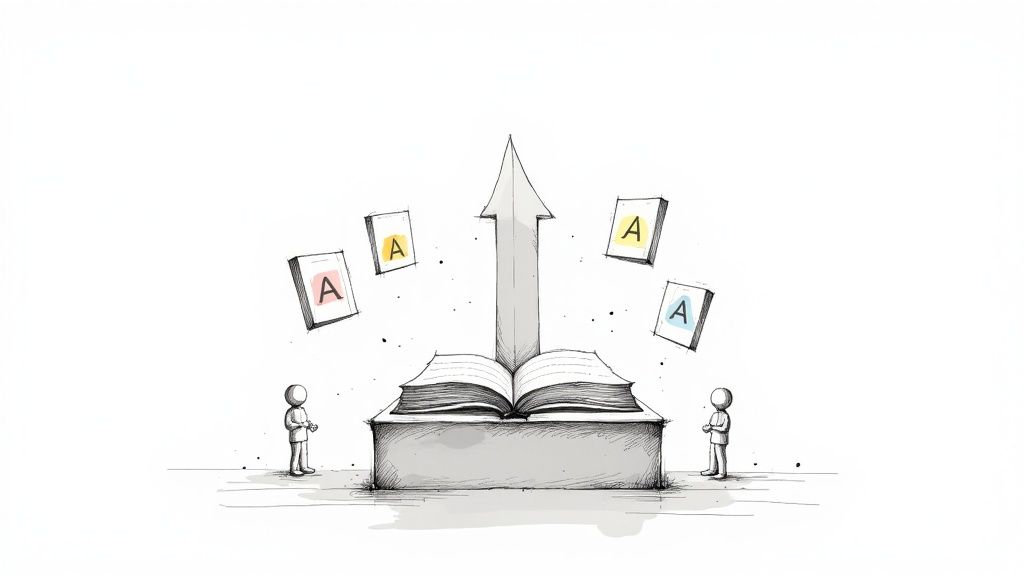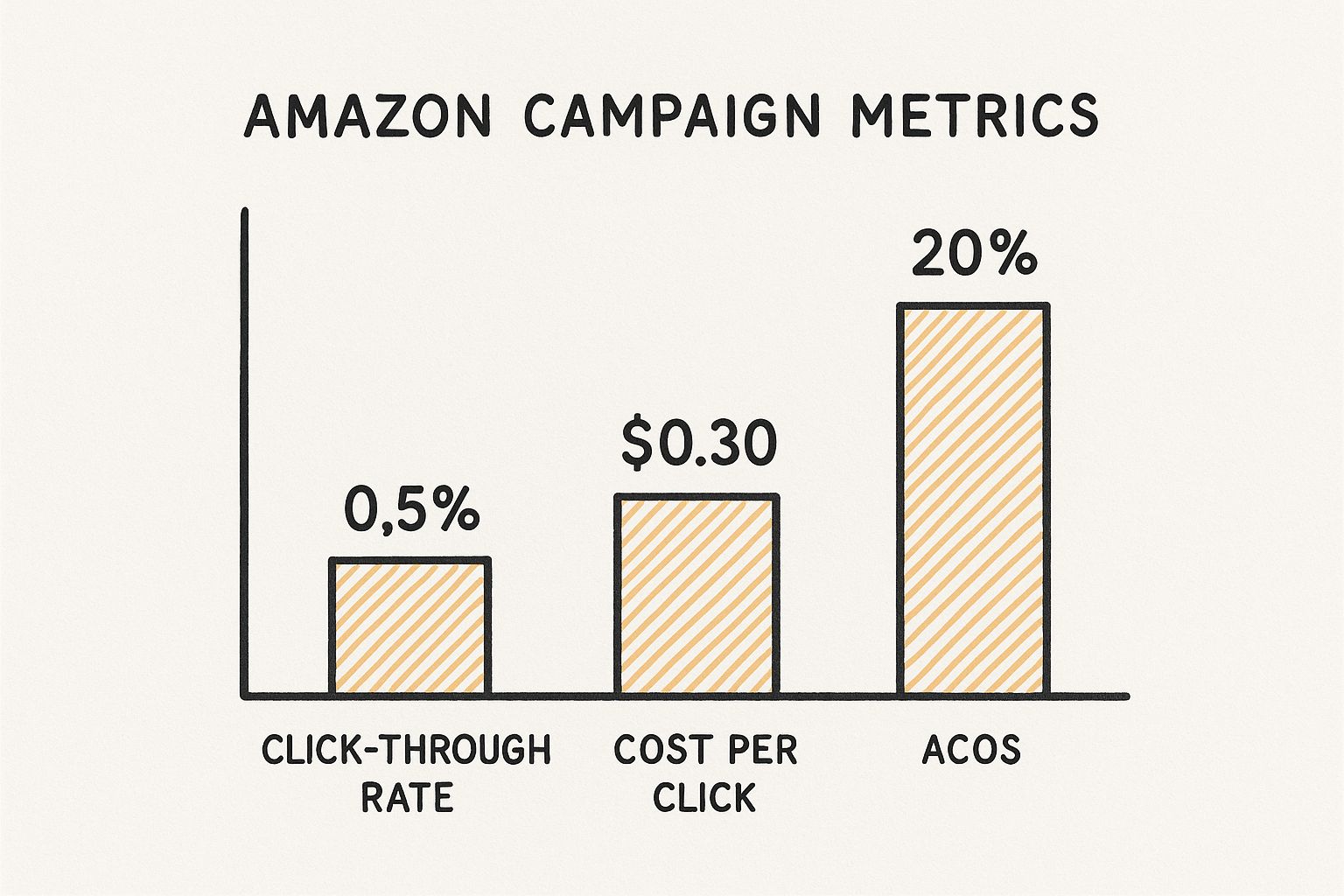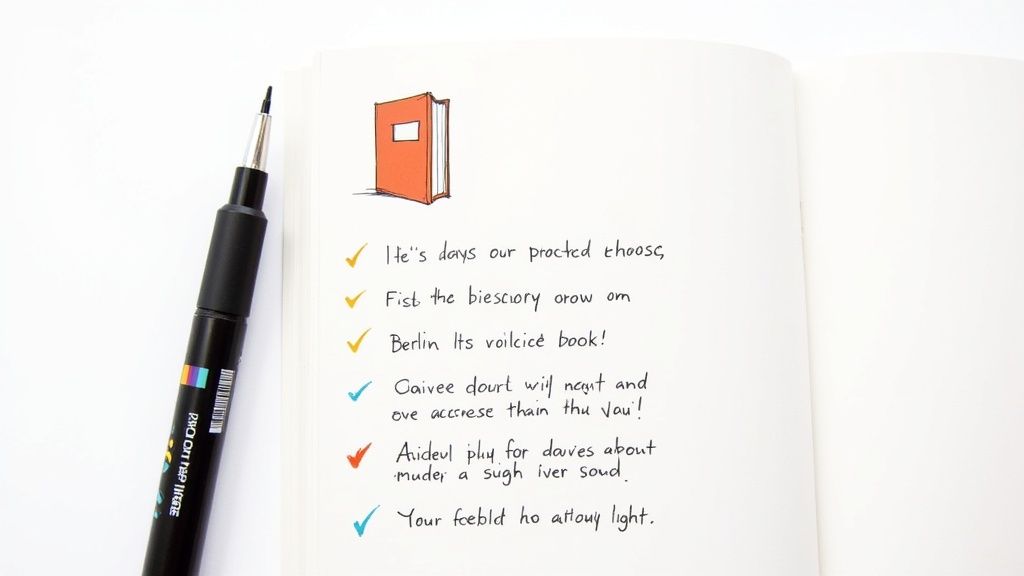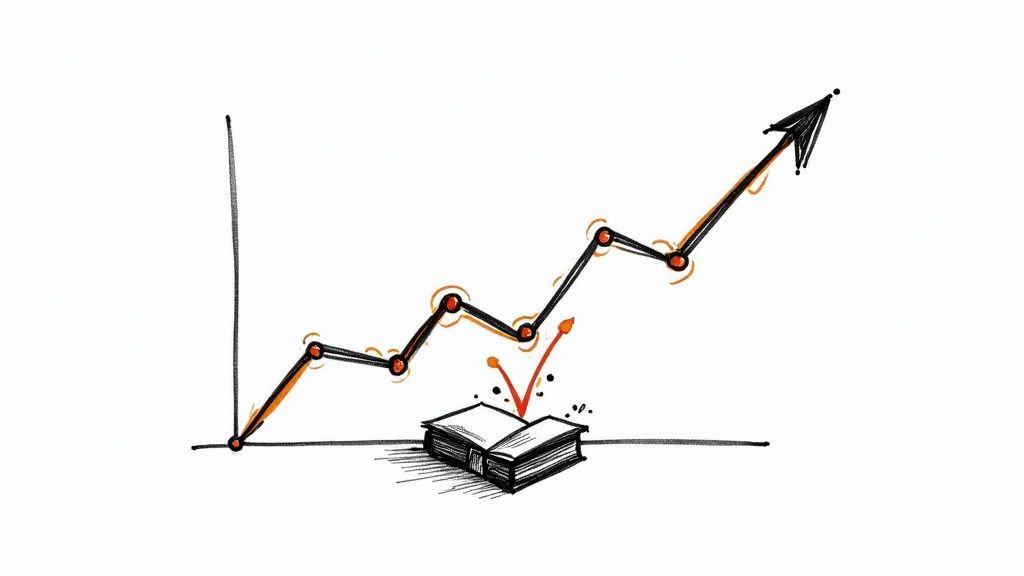How to Advertise a Book on Amazon and Attract Readers

If you want to sell your book on Amazon, you can't just publish it and hope for the best. You need to get in front of readers, and the best way to do that is with Amazon Ads. It's a pay-per-click platform that puts your book right where shoppers are looking for their next read. This means creating smart, targeted campaigns using keywords and categories that match your genre. Getting this right comes down to having a great book page and a solid strategy for your bids and budget.
Why Amazon Ads Are a Game-Changer for Authors

Trying to get your book noticed on Amazon without any marketing feels like shouting into a hurricane. There are literally millions of other books all competing for the same eyeballs. Relying on organic discovery alone just isn't enough to build the momentum you need. This is where a sharp advertising strategy stops being an expense and becomes one of the most important investments you can make.
Tap Into a Massive Reader Marketplace
Think about it: Amazon isn't just a store; it's the biggest bookstore on the planet, and your readers are already there. The numbers are pretty staggering. Amazon commands around 50% of all print book sales in the U.S. and an incredible 67% of e-book sales. With books being the most popular product category on the site, you have a massive audience that's actively looking to buy.
This is what makes Amazon Ads so powerful. You're not trying to distract someone scrolling through social media. You’re putting your book in front of them right at the moment they’re deciding what to read next.
The real magic of Amazon Ads is placing your book in front of high-intent buyers exactly when they're ready to make a purchase. It’s the digital version of getting that prime shelf space right at the front of the store.
Key Advantages for Authors
Running ads on Amazon gives you a serious competitive edge by getting more eyes on your book and driving the right kind of traffic to your page.
Here’s what you stand to gain:
- Skyrocket Your Discoverability: Your book will pop up in prime locations, like the top of search results or on the product pages of similar books.
- Pinpoint Your Audience: You can zero in on readers based on what they search for, their favorite genres, or even other authors they love.
- Boost Your Sales Velocity: A successful ad campaign can kickstart your sales rank, which tells Amazon's algorithm to show your book to more people organically.
At the end of the day, a well-run campaign can take a brand-new author from total obscurity to the first page, turning casual browsers into dedicated fans. For a wider look at your promotional options, check out our guide on https://manuscriptreport.com/blog/how-to-advertise-your-book, which covers a bunch of different strategies.
Choosing the Right Amazon Ad for Your Book
Before you spend a single dollar on Amazon ads, you need a game plan. The key is matching what you want to achieve with the right kind of ad. Amazon gives you a few different tools, and picking the right one from the start is the best way to avoid burning through your budget with nothing to show for it.
We'll be looking at the three main ad types you’ll encounter: Sponsored Products, Sponsored Brands, and Sponsored Display.
Sponsored Products: The Frontline Sales Tool
Think of Sponsored Products as your workhorse. These ads are fantastic for getting your book in front of people who are already shopping. They pop up right in the search results and on the product pages of other, similar books.
This is your go-to for a new launch or if you just want to drive direct sales. For instance, if you've written a cozy mystery, you can set up your ad to appear when someone searches for "Agatha Christie" or looks at a book by Louise Penny. You're putting your book directly in the eyeline of your ideal reader at the exact moment they're looking to buy.
Sponsored Brands: Building Your Author Name
Once you’ve published a few books, Sponsored Brands ads are where you can really start building your author platform. Instead of promoting just one book, these banner-style ads showcase your author brand. They appear at the very top of the search results and feature your logo, a custom headline, and a collection of up to three of your books.
This is less about an instant sale and more about establishing yourself as an author. A sci-fi author with a three-book series could create a banner with a headline like, "Enter the Nebula Rift: An Epic Space Opera Trilogy." It’s a powerful way to build name recognition and encourage readers to explore your entire backlist.
The image below gives you a sense of some benchmark numbers for Amazon ads, including things like click-through rates and Advertising Cost of Sale (ACOS).

These metrics highlight that even a small, well-managed budget can get results. Keeping a close eye on your ACOS is essential to make sure your campaigns are actually making you money.
Sponsored Display: Winning Back Lost Readers
Finally, we have Sponsored Display ads. These work a bit differently. Their main superpower is retargeting—reaching readers who have already looked at your book's page but didn't click the "buy" button.
These ads can follow a potential reader around Amazon and even onto other websites and apps, gently reminding them about your book.
It’s the digital equivalent of a reader picking up your book in a store, putting it down, and then seeing it again on a display by the checkout counter. That second look is often all it takes to turn a browser into a buyer.
To help you decide where to start, here's a quick breakdown of the different ad types and what they're best for.
A Quick Guide to Amazon Ad Types for Authors
This table offers a straightforward comparison of Amazon's main ad formats, their ideal use cases, and targeting methods to help you choose the best strategy for your book.
| Ad Type | Best For | Targeting Options | Where It Appears |
|---|---|---|---|
| Sponsored Products | Driving sales for a single book, new launches, reaching active shoppers. | Keywords, specific products (ASINs), categories, author names. | Top of search results, within search results, on product detail pages. |
| Sponsored Brands | Building author brand awareness, promoting a series or collection. | Keywords, specific products (ASINs), categories. | Prominent banner at the top of search results, custom landing pages. |
| Sponsored Display | Re-engaging readers who viewed your book but didn't buy, building audience loyalty. | Views retargeting, interests, product categories. | On and off Amazon, including competitor product pages and third-party sites. |
Each ad type has a unique role to play in a well-rounded marketing strategy. Understanding them is the first big step toward a profitable campaign. For a deeper dive into other promotional tactics, our guide on book marketing for self-published authors demystified covers more ground.
Kicking Off Your First Amazon Ad Campaign

Alright, this is where the rubber meets the road. Setting up your first Amazon ad campaign for your book can feel like a lot, but don't get bogged down in the details. The trick is to focus on a few key decisions that will actually move the needle. Your goal isn't perfection right out of the gate; it's about establishing a solid baseline that you can tweak and improve over time.
The first big choice you’ll make is your targeting type. Amazon essentially gives you two ways to go: automatic or manual.
Automatic Targeting: Think of this as Amazon's "set it and forget it" option. You give it a budget, and its algorithm goes to work, analyzing your book's genre and metadata to figure out where your ad should appear. It's a fantastic way to uncover which search terms and product pages actually lead to sales, all without any heavy lifting on your part.
Manual Targeting: With this one, you're in complete control. You hand-feed Amazon a list of specific keywords, author names, or even the ASINs of competitor books where you want your ad to show up. It demands more upfront research but gives you surgical precision.
For most new authors, a great strategy is to run both an automatic and a manual campaign at the same time, each with a small budget. Let the automatic campaign do the discovery work for you, revealing powerful keywords you never would have thought of on your own.
Nailing Down Keywords and Bids
Keyword research doesn't have to be some complex, drawn-out process. Just put yourself in your ideal reader's shoes. What would a hardcore fantasy reader actually type into the search bar? Probably terms like "epic fantasy with dragons," "magic academy series," or the names of authors like Brandon Sanderson.
A classic rookie mistake is chasing only broad, super-competitive keywords. You'll get much better results by focusing on long-tail keywords—those longer, more specific phrases like "military sci-fi with alien invasion"—which almost always have less competition and a much higher chance of converting a browser into a buyer.
Once you have a solid list of keywords for your manual campaign, it's time to talk money: your budget and your bids. Your bid is simply the most you're willing to pay for a single click on your ad, which is often called the Cost-Per-Click (CPC).
Amazon will suggest a bid range, but I've found it's usually best to start toward the lower end of that suggestion. A bid between $0.25 and $0.40 per click is a safe place to begin. You can always adjust it later based on what the data tells you. For your daily budget, you can start as small as $5 per day—that's more than enough to start gathering the initial performance data you need.
Remember, a staggering 75% of Amazon shoppers never even look past the first page of search results. This makes a tightly focused campaign absolutely critical for getting seen.
How to Structure Your Campaigns for Real Results
Whatever you do, don't just throw all your keywords into a single, messy campaign. A little organization now will save you massive headaches later when you're trying to figure out what's working and what's just burning through your cash.
I recommend starting with this simple, three-part structure:
- One Automatic Campaign: Let this one run wild. Its only job is to collect data and find opportunities.
- One Manual Keyword Campaign: This is where you'll target the specific search terms you think your readers are using.
- One Manual Product Targeting (ASIN) Campaign: Use this to place your ad directly on the product pages of popular, similar books in your genre.
This setup gives you a clean, easy-to-read dashboard showing you exactly which strategy is driving your clicks and, more importantly, your sales. As you get more comfortable and want to dig deeper into the mechanics of managing bids and optimizing your ad spend, you'll find a comprehensive guide to PPC for Amazon to be an invaluable resource.
Getting Smart with Your Ad Performance Data
Launching your campaign is just the starting line. The real magic—and the real work—happens once the data starts trickling in. Don't worry, you don't need a Ph.D. in statistics to figure out your Amazon ads. It really just comes down to watching a few key numbers to see what's connecting with readers and what’s just burning through your budget.
Forget the intimidating dashboard with its endless columns of data. When you're just starting, you can ignore almost all of it and focus on four things:
- Spend: The raw amount you've paid Amazon so far. Simple enough.
- Clicks: How many people saw your ad and were curious enough to click.
- Orders: The number of people who actually bought your book after clicking.
- ACoS (Advertising Cost of Sales): This is the big one. It’s the percentage of your sales revenue that you're spending on ads.
Think of ACoS as the health meter for your campaign. It’s what tells you if you're actually making money. For example, if you earn a 60% royalty on your book and your ACoS is 45%, you're in the green. Every sale driven by that ad is putting money in your pocket.
Making Sense of the Numbers
Let your ads run for at least a week to gather some meaningful data. Then, it's time to put on your detective hat. Your automatic campaigns are an absolute goldmine for finding keywords you never would have thought of.
Open up the search term report for your automatic campaign. You’re looking for the exact phrases real customers typed into Amazon right before they bought your book.
Let's say you wrote a thriller and discover the phrase "fast-paced psychological thriller" led to three sales. Bingo! That's a proven winner. The next step is to immediately pop that keyword into your manual campaign. By doing this, you can set a higher, more intentional bid for it, making sure your ad shows up more often for that highly profitable search.
Optimization really boils down to this: find what's working and pour more fuel on it. Find what isn't working and cut it loose. It’s a constant cycle of testing and tweaking that turns a tiny ad budget into a reliable sales engine.
At the same time, you need to be on the lookout for search terms that are just wasting your money. If your epic fantasy novel is somehow getting clicks from people searching for "historical romance novels," every one of those clicks is a waste. Add "historical romance" to your negative keywords list for that campaign. This simple action tells Amazon, "Hey, don't show my ad to these people," which instantly tightens up your targeting and saves you money.
What Does "Good" Look Like?
A well-run ad campaign is a non-negotiable part of an author's strategy these days. To see how ads fit into the bigger picture of your author platform, it’s worth learning more about digital marketing for authors to boost book sales.
Industry-wide, the average conversion rate for Amazon ads hovers around 9-10%. But for books, I’ve seen well-managed campaigns consistently hit 10-15% or even higher. For more stats, you can find some great insights on Amazon advertising stats on adbadger.com.
To really level up your skills, it helps to zoom out and start understanding key digital marketing performance metrics beyond the Amazon dashboard. This broader knowledge will help you make smarter decisions not just for a single campaign, but for your entire author career.
Common Amazon Ad Mistakes Authors Make (And How to Avoid Them)

Learning to run profitable book ads on Amazon is often a masterclass in what not to do. I’ve seen countless authors dive in headfirst, make a few costly errors, and walk away convinced that "Amazon ads just don't work."
But they do work. You just have to sidestep the common traps that drain your budget and your morale.
Don't Advertise a Book That Isn't Ready
One of the most frequent—and expensive—mistakes is throwing ad spend at a book that simply isn't ready for paid traffic. Think of it as trying to fill a leaky bucket. You can pour all the money you want into ads, but if your book's foundation is weak, you're just wasting cash.
Before you spend a single dollar, make sure your book has a solid base.
- A Professional Cover: Your cover is your book's billboard. If it looks amateurish, readers will assume the writing is, too, and scroll right past your ad. No exceptions.
- A Compelling Blurb: That book description has to be sharp, engaging, and sprinkled with the keywords your ideal reader is searching for. It needs to hook them and not let go.
- Sufficient Reviews: Social proof is everything. I always advise authors to wait until they have at least 10-15 positive reviews before running ads. Very few people will take a chance on a book with zero or just a couple of reviews.
The Pitfall of Impatience
Another huge blunder I see is panicking too early. It's so tempting to refresh your campaign dashboard every hour, but you have to resist. Amazon Advertising's algorithm needs time—often one to two weeks—to gather data and figure out who to show your ad to.
Shutting down a campaign after just a few days because it hasn't generated a sale is a classic rookie move. You're pulling the plug before the machine has even had a chance to warm up.
Don't even think about judging a campaign until it's gathered at least 1,000 impressions. Making a call before that is like judging a novel by its first sentence—you simply don't have enough information.
This impatience often stems from a lack of clear goals. Without a specific objective, how can you possibly measure success? Are you aiming for pure profit, or are you investing in visibility for a new launch? Knowing your "why" helps you interpret metrics like ACoS (Advertising Cost of Sale) correctly.
Finally, stop targeting incredibly competitive, broad keywords right out of the gate. Bidding on a term like "fantasy" is a surefire way to blow your budget. Instead, get specific. Target long-tail keywords like "epic fantasy with female protagonist" to find readers who are actively looking for a book just like yours. You'll spend less and get better results.
Common Questions from Authors
How Much Should I Actually Spend on My Book Ads?
This is the big question, isn't it? While there’s no single "right" answer, I've found a solid starting point is $5 to $10 per day for each campaign.
This budget is the sweet spot. It's just enough to start collecting real, usable performance data without you having to drain your bank account. Once you see which ads are actually selling books, you can confidently start putting more money behind them.
When Will I Finally See Results?
This is where patience really pays off. It's so tempting to check your dashboard every hour, but you have to let your campaigns breathe. I always tell authors to let a new campaign run for at least two to four weeks before even thinking about making big changes.
Why so long? It gives Amazon’s algorithm enough time to figure out who your ideal reader is and where to show your ad. Cutting it short means you're making decisions based on incomplete, unreliable data.
What’s a Good ACoS, Really?
What's considered a "good" Advertising Cost of Sales (ACoS) completely changes depending on what you're trying to achieve right now. It's not one-size-fits-all.
- If your goal is profit: Your ACoS has to be lower than your royalty percentage. For example, if you earn a 70% royalty on each sale, your ACoS needs to stay under 70% to be in the black. Simple as that.
- If your goal is visibility: Things look different, especially during a book launch. A high ACoS, even over 100%, can be a strategic investment. You're essentially buying data, reviews, and a higher sales rank that can lead to more organic sales down the road.
Ready to turn your manuscript into a marketing powerhouse? ManuscriptReport.com generates your blurbs, keywords, ad copy, and more in minutes. Get your complete book marketing report today!
Related Articles

The Ultimate Affordable Book Launch Checklist: 9 Essential Steps for 2025
Complete affordable book launch checklist for 2025. Follow 9 proven steps—from budget planning to post-launch—for indie and self-published authors. Launch successfully for under $500.

How to Write Viral Book Hooks: 10 Proven Strategies for Social Media Success
Master the art of viral book hooks with 10 proven strategies, platform-specific tactics, and templates that grab attention on BookTok, Instagram, and beyond.

7 Must-Have AI Writing Tools for Authors
Discover essential AI writing tools for authors to boost creativity and streamline marketing. Learn actionable tips and explore solutions like ManuscriptReport.com.